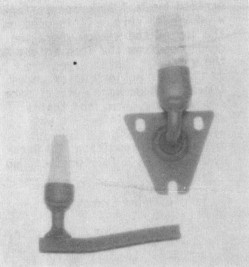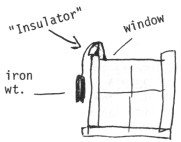Research Division
Reprinted from "INSULATORS - Crown Jewels of the Wire", November 1977, page 24
Dear Dora,
Recently I was looking over some of my insulators in preparation for the
Kansas City Show (August 27-28). I noticed that one of my CD 125 "No Names"
did
have some embossing on it. It appears to be a patent date. It is very weak, but
partially readable. Some of it has been blocked out by what appear to be
groups of small, period-like dots. The embossing is on the center of the skirt,
and what can be read follows:

The insulator itself is made of light aqua glass, common for this style.
I
also checked out all of my other CD 125 No Names, and found that the embossing
and blocking was present on all of them, to a lesser degree. Usually, the
"JAN" was readable, but only if you looked for it.
Could you please ask
your readers whether they, too, can find embossing on any No Name 125's?. I
would like to determine what the rest of the embossing is and the Patent that
it refers to. My guess would be a Brookfield patent. Do any of you readers have
any suggestions as to which January patent date it could be? Thanks!
Sincerely,
Chuck Moylan
3319 Red Bridge Rd., Apt. 6
Kansas City, MO 64137
Dear Dora,
I would like to ask about a wood strain insulator with iron end
caps. I have seen photos of these, but am unaware of any embossings or who may
have manufactured them. I found two of these, both of them embossed the same.
They are 12' long, with the wood portion being 5". Each iron end cap is
stamped on the side as follows:
815944
XCS
I estimate these were installed about
1910 to 1920. The wood is in excellent condition, although they were continually
exposed to the weather.
I really enjoy the Crown Jewels. It provides a good
media for new finds and research. I have enjoyed all the collectors that I have
met personally, and also the ones I have corresponded with through the ads, plus
the directory you publish each year. Again thanks for providing a great
publication.
Sincerely yours,
Jim Woods
- - - - - - - - - -
Jim:
These wooden strains are manufactured to A.T.A. specifications and have been
cataloged for many years by Westinghouse, Ohio Brass Co. -- and possibly others.
They are primarily used for insulating the non-insulated hangers. The number on
yours fits the Westinghouse numbering scheme.
We ran a five-page article on these in the September 1971 C.J., pages
23-27; and they are also pictured in Gerald Brown's book, Unique Collectible
Insulators, page 12. One or more of these wooden strains certainly make an
attractive addition to any collection.
Dora

Dora -
I need some researching help on these insulator pin brackets. Came from a
dump (Ref: Sept. 1977 issue, p.p. 22-23), and just don't look the part of an
insulator bracket -- more like candle holders? Have these turned up before? I
hope that you can help me out on these interesting brackets.
Thank you
John de Sousa
- - - - - - - - - -
John:
I'll grant you, they do look like candle holders and quite probably could be
used as such; but I do believe they are insulator pin brackets. I have an old
1917 Northern Electric Company General Supply Catalogue, and they do list a few
iron wall brackets that aren't exactly like your picture, but are close enough
(probably made by different companies), and they state the bracket will
accommodate a 1-1/2" or 1-1/4" pin. Perhaps these are the forerunners
of the all one piece bracket and pin.
If anyone has any old catalogues of other companies, perhaps you can help us
out with information as to which company manufactured these two pictured
brackets.
Dora
Dear Don & Dora:-
Saw Bob Brophy's letter, page 36 of Sept. Crown Jewels.
We have these two W.T. "miniatures". We got them in a trade in 1969
from some folks who lived in Bloomington, Ind. They said there had been a
convention in their town about ten years before, and these small insulators were
table decorations at the banquet at Indiana University. They didn't know how
many there were; but at least that established their existence about 1959, and
one use for them.
Yours,
Frank Miller
1720 West Pine
Tulsa, OK 74127
P.S. Also picked up the DISTRIBUTION one in lead at the Cob. Springs show. We
wondered if someone had the mold and was making them; but we've never seen any
more in lead.

Dear Dora,
In reference to CJ August 1977, page 35, the "insulator"
described by Jarl Anderson is for window sash cord. It is used on the top of the
window where the cord goes from the iron weight to the window. These served the
function of pulleys which some- times stuck or wore out. I once saw one at a
show, and that's where I got my info. It was valued at $20.00.
Does anyone out there have a decent condition 719 Saratoga threadless? I am
looking for one at a fair price to go with my bottle collection.
Thanks,
Richard Strunk
R.D. 4
Clifton Park, NY 12065
Dear Dora,
I'd like to reply to a letter in the Research Division of the September issue
of Crown Jewels. Bob Brophy wrote about a couple miniature insulators he
has acquired in the south New Jersey area, and had two excellent photos of the
pieces.
These miniatures were made by Armstrong Cork Co. at their Millville, N.J.
plant to be used as paperweights. They were handed out by salesmen when they
called on insulator buyers. I have both of the pieces Bob described in his
letter, except my miniature of the C.D. 216 is amber, not clear. As far
as I know, the two styles shown in the photos were the only two ever produced.
They sure make a nice addition to any collection, but I suspect that very few
were made, so they are quite rare.
Dick Johnson
White Bear Lake, Minnesota
| 